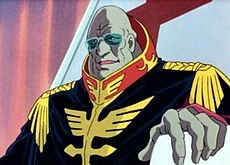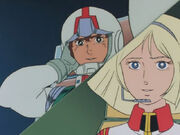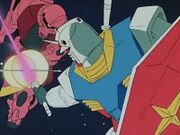At the same time, the tension between dimensions generates ideologies. Ideologies are attempts to combine, in an "impossible" synthesis, the diverse and contradictory longings embodied in and played out along different dimensions. Borrowing a formulation from Fredric Jameson, they are ideal solutions to real contradictions. Because they are grounded in a real longing to solve or surpass the contradictions, they also contain a utopian element that points beyond them. Sparks of utopia reside even in the most ideological works.
Liberalism and fascism
For an example, let me turn to Mobile Suit Gundam, the classical Japanese anime that was aired as a TV series in 1979 and reedited for theatrical release in 1981. The setting is the war waged between the Earth Federation and one of its breakaway colonies, called Zeon. Zeon is initially successful, achieving great military victories and wrecking havoc with the earth. The Earth Federation, however, manages to develop a gigantic robot-like "mobile suit" named Gundam. Piloted by a young boy called Amuro, Gundam helps turn the tide of war.
| Statue of Gundam in Odaiba |
Zeon is ambiguious in a way that indicates that it lies at the crossroads of several separate axes or dimensions structuring the work. It appears equipped with all the attributes of a prototypical evil foe, such as militarism and authoritarianism. Many of its attributes evoke Nazism. At the end of the first film, during Gihren Zabi's "Sieg Zeon" speech, the grey masses are grouped in endless rectangular formations reminiscent of the Nuremberg rallies and the speaker calls Zeon a chosen people. And the flag of Zeon is a pastisch of the Nazi war flag.
 |
| Degwin Sodo Zabi, ruler of Zeon |
| Lalah Sune and Char Aznable |
Newtypes and oldtypes
Yet the existence of another, even more important axis in the film makes things more complicated. This is the axis along which the conflict between "newtypes" and "oldtypes" is played out. The newtypes are human beings such as Amuro and Char who have developed paranormal abilities due to their exposure to the environment of outer space - abilities that include heightened powers of perception and intuition, increased agility of movement and the ability to communicate telepathically. The newtypes, however, suffer discrimination by the oldtypes, the old humanity on earth.
 |
| Two newtypes: Amuro and Sayla Mass |
We can now note an important pecularity with the film that arises from the way in which the "newtype-oldtype" axis intersects with the "liberalism-fascism" axis. Although the film portrays Zeon as a quasi-Nazi dictatorship against which Gundam serves as a bulwark, it accepts an important part of its ideology. In the film, newtypes really exist and have superior abilities. The evolution of humanity prophesied by Zeon Zum Deikun really takes place. It’s a little bit as if an ostensibly anti-Nazi film had portrayed Germans as actually superior to Jews. Or, for that matter, an anti-colonial film in which white actors get all the important roles (not so uncommon, right?).
The film's very structure seems to privilege the newtypes. They are clearly portrayed as the principal players in the war, as the heroes on which the fate of the rest of humanity will depend. Amuro himself is a newtype who grew up on one of the Earth Federation's space colonies and therefore fights on its side. Newtypes thus take part on both sides of the war. All the film's climactic battle scenes depict newtypes flying around in their huge mobile suits fighting each other. The result, as Ian Condry observes, is that the war appears to be played out on an “action-movie scale", the battles hinging on "a limited number of heroes and rivals that hardly characterizes actual wars" (Condry 2013:126). A sense of commonality and even mutual respect seems to exists between newtypes on both sides in the war. Their relations are guided by a kind of warrior ethic which the film seems to endorse. Despite being Amuro's main antagonist, Char is sympathetically portrayed and appears to have been as popular among viewers as Amuro. Indeed, Amuro and Char are portrayed as “two worthy opponents… neither of which is more or less evil than the other” (Murakami 2005:31). Speaking of a warrior ethic, is it a coincidence that Gundam resembles a knight in shining white armour so much?
 |
| Amuro and Char |
Otaku and new ethnicities
This blend per se is not unfamiliar. One only need to think of Hollywood. How many movies exist that celebrate tough police officers who protect "liberal" America precisely by their readiness to break the rule book? One could also think of Kurosawa, whose films have been described as pervaded by an impossible desire to combine Confucian hierarchy with socialist egalitarianism (Wernström 1996).
But Gundam goes further than this. To appreciate why the film strives to create an ideological synthesis out of the two axes it is necessary to ask why the reigning "liberal" order of postwar Japan on its own is felt to be insufficient or oppressive at least to some groups in Japan. Critics have often linked the “newtype” idea to the otaku subculture. As the renowned pop-artist Murakami Takashi points out, it functions as a subcultural ideology portraying the seemingly sloppy, asocial and abnormal lifestyles of otaku as the seed of a new future humanity with superior abilities. Murakami describes Amuro as “an otaku-like, machine loving introvert who accidentally becomes the pilot of the Gundam; far from heroic… Amuro prefigured the purposeless Shinji Ikari of Neon Genesis Evangelion” (Murakami 2005:31).
This means that rather than rather than an abstract struggle between “liberalism” and “fascism”, the quandary from which the film departs is that contemporary Japan and its youth. The new types who have developed a new sensibility thanks to their adaptation to a new environment are the same as the young generation, living in a new time which they understand better than their parents, yet feeling discriminated and harassed by then as well as by teachers and mass media.
 |
| New Jerusalem |
By reading the newtypes as "new ethnicities", Ueno affirms the utopian side of the newtype ideology as against its fascist appropriation. Zion is of course a word loaded with utopian connotations - the Heavenly City, the New Jerusalem that will be free from oppression. It would even be possible to read the evolution of newtypes as heading in an angelic direction, with humans growing more spiritual and less limited by their material body.
| Amuro |
...is a shy, antisocial New Type who awakens to war. It is inevitable that humans who are born and dwell in low-gravity space, with radiation levels that far surpass those on earth, will be fundamentally different from humans born and raised on this planet. For the Japanese, the hope that a New Type will emerge in this environment is an inevitability, born of the confluence of reality and postwar trauma. (ibid.)Murakami's intention is not to criticize otaku culture, but rather to affirm it as a culture of "deformed monsters". From his perspective, it is precisely by identifying as a pathetic otaku in need of the newtype ideology that new possibilities of authentically grappling with postwar Japanese history open up. While this reading helps turn Gundam into a tool of criticism against the postwar Japanese order and superficial nationalist self-images of Japan as a country of refined beauty, a further merit is that it helps bring into view the pain and desperation fuelling the newtype ideology. If his interpretation is correct, it is out of despair at having failed as a normal human that some people simply must hope for the development of compensatory special abilities of the newtype sort.
Ian Condry sheds some light on this desperation in his recent book The Soul of Anime. Here he discusses petitions launched by self-proclaimed otaku for the legal recognition of marriage to 2D characters. He quotes the otaku spokesman Tôru Honda (a.k.a. "the Radiowave Man") who deliberately opts for 2D characters, dismissing those who prefer real people ("3D characters") as being behind the times. “One can read Radiowave Man’s manifesto not primarily as a rejection of relationships with real women but, more imporant, as a defense of failed men”, Condry comments (2013:194). To explain this sense of failure, Condry refers to masculinity studies which explain “why so much otaku-oriented anime contains troubled male protagonists who essentially reimagine the hero as vulnerable, and anything but all-powerful” (ibid.). The apex of this development is Shinji in Evangelion, but the prototype of this sort of male was Amuro. Condry continues that “an otaku perspective on masculinity reminds us of the vulnerability experienced by many men who live outside the dominant ideal of male success” (ibid. 195).
| Dameren, a movement for defending failures and for a society in which no-one needs to be a loser |
References
Back, Les (1996) New Ethnicities and Urban Culture, London: UCL Press.
Condry, Ian (2013) The Soul of Anime: Collaborative Creativity and Japan’s Media Success Story, Durham: Duke University Press.
Drazen, Patrick (2006) “The Shock of the Newtype: The Mobile Suit Gundam Novels of Tomino Yoshiyuki”, Mechademia, Vol. 1: 174-177.
Hall, Stuart (1992) ”New Ethnicities”, pp 252-259, in James Donald & Ali Rattansi (eds) ’Race’, Culture and Difference, London: Sage Publications.
Murakami, Takeshi (2005) “Earth in my Window”, pp 98-149, in Little Boy: The Arts of Japan’s Exploding Subculture, New Haven: Yale University Press
Ueno Toshiya (1998) Kurenai no metaru sūtsu: anime to iu senjo (Red Metal Suits – Animation as Battleground), Tokyo: Kinokuniya shoten.
Wernström, Göran (1996) Medvetet/omedvetet och filmberättande: en studie i Akira Kurosawas film Sju samurajer, Lund: Lund University.
No comments:
Post a Comment